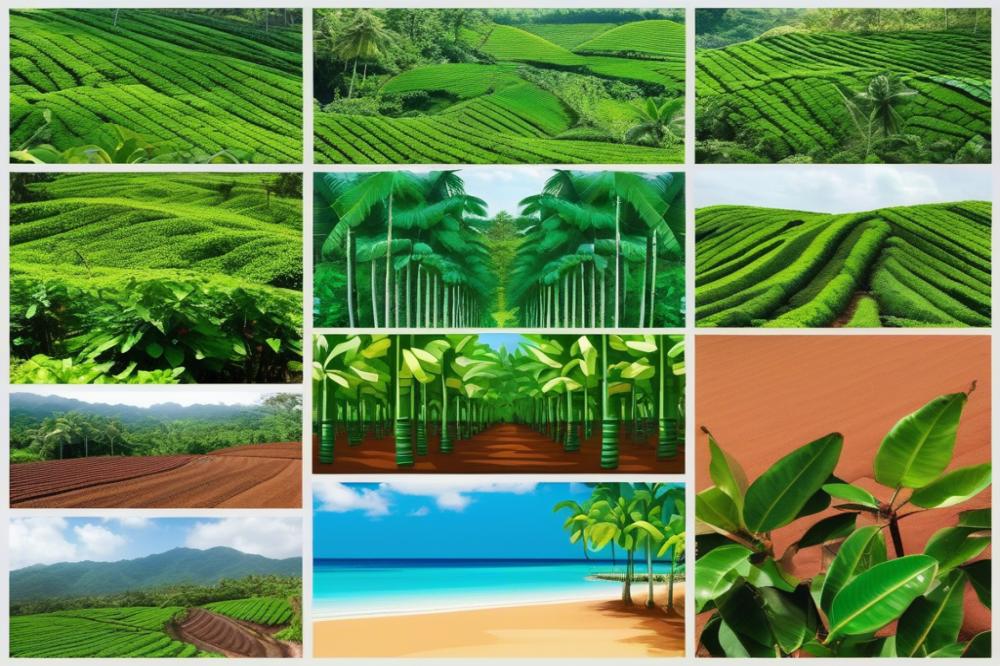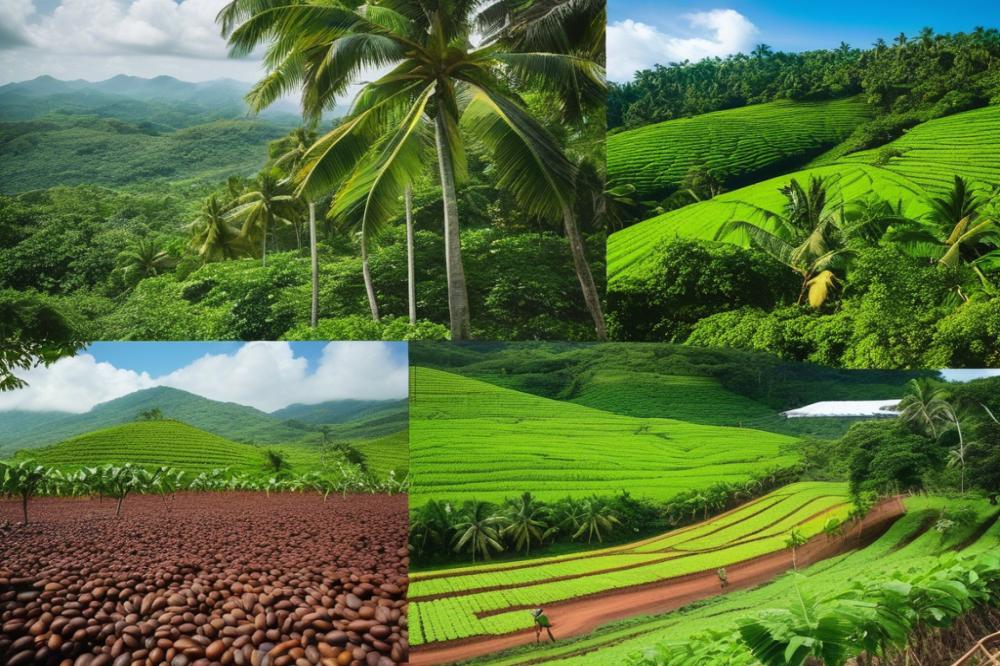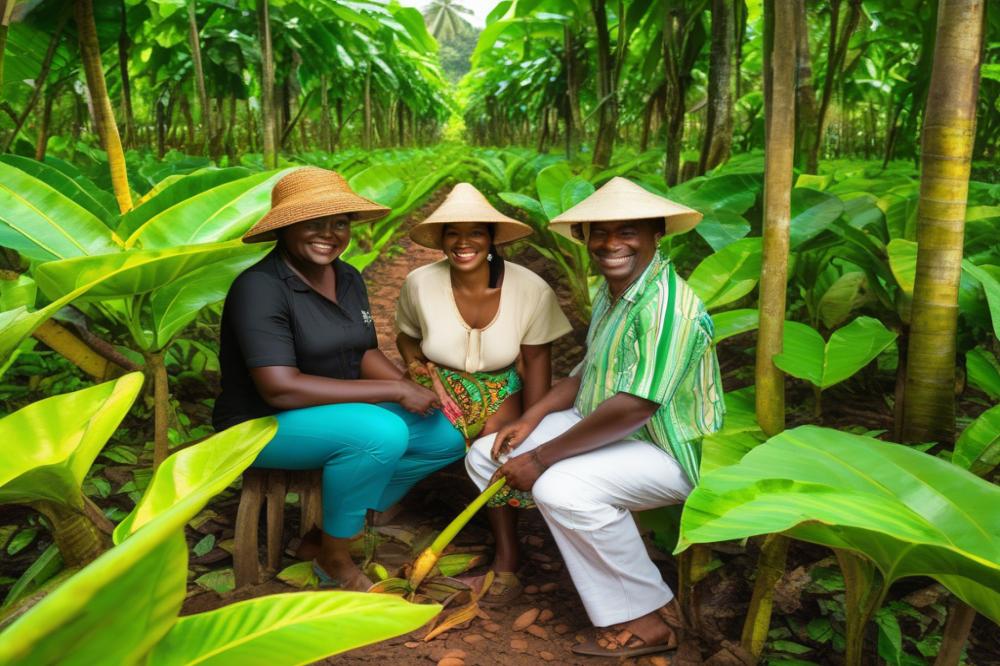Overview of Cocoa Farming in the Caribbean
Cocoa has a rich history in the Caribbean. It plays a vital role in the history of chocolate. For centuries, cacao beans have been cultivated here. People have thrived on this agriculture, influenced by the region’s unique climate. It’s fascinating to see how Cocoa Farming has shaped economies and cultures.
Colonialism greatly impacted the trade of cacao. European powers recognized its potential, leading to the establishment of plantations. This not only increased the availability of cocoa but also transformed social structures. Indigenous practices blended with European techniques, paving the way for new farming methods. These farming techniques have been refined over generations, contributing to the sustainability of cacao production.
Cocoa’s economic impact is significant. It supports farmers’ livelihoods and contributes to local economies. Many families depend on cacao farming for survival. Cacao also holds cultural significance in various communities. It is often celebrated in local traditions and festivities. The journey from bean to chocolate reflects not just labor, but heritage and identity.
Understanding the full scope of cocoa in the Caribbean can deepen our appreciation for chocolate. It’s not merely a sweet treat; it’s a product of a complex history and vibrant cultures. As we explore further, we will uncover the intricacies of this cherished crop.
The Origins of Cocoa Farming in the Caribbean

Introduction of cacao by Indigenous peoples
Cacao has deep roots in the Caribbean. Indigenous peoples were the first to cultivate this precious plant. They used cacao in various ways, far beyond just making chocolate. This bean held magic as a drink used in ceremonies and important rituals. It was highly valued, sometimes even used as currency. Cacao was vital to their economy and culture, symbolizing wealth and power.
Early agricultural practices and significance
The farming techniques employed by Indigenous groups were quite advanced. They understood the importance of planting and harvesting at the right times. Sustainability was key in their agriculture. Methods included the creation of small gardens in forest clearings, which allowed for diverse crops to thrive alongside cacao. This practice also protected the environment. Cacao trees were cherished for their unique qualities. Besides trade, these beans played a crucial role in community life, strengthening bonds among people. They recognized that cacao was not merely a crop, but a cornerstone of their existence.
Impact of European contact and colonialism
With European contact, everything changed dramatically. Colonizers quickly saw the economic potential of cacao. They sought to exploit these resources for profit. This shift in focus led to the establishment of plantations, often using enslaved laborers. The agriculture of cacao transformed into a large-scale industry. European powers began to monopolize trade routes. This increased the demand for chocolate in Europe. Yet, the effects of colonialism were devastating for Indigenous cultures and societies.
Their agricultural wisdom was soon overshadowed by foreign interests. Cacao production became linked closely with colonial economies. The economic impact was profound, as local communities faced displacement and loss. Thus, the story of cacao in the Caribbean is a mix of rich history and difficult legacies.
Development of Cocoa Farming During Colonial Times

Establishment of plantations and trade systems
Cacao cultivation began in the Caribbean during colonial times. European powers sought cash crops to maximize profits. Plantations were established across numerous islands. The demand for chocolate increased rapidly in Europe, fueling the trade. These plantations needed a large workforce. As a result, a system of trade for agricultural goods was connected with the establishment of plantations. Cacao grew alongside sugar and tobacco as vital exports. Ships carried these goods back to Europe, creating a significant market.
Use of slave labor in cocoa production
To support the new plantations, colonial powers turned to slavery. Enslaved Africans were forced to work long hours under harsh conditions. They practiced farming techniques that improved cacao production. Lives of millions were affected by this brutal system. The use of slave labor allowed owners to maximize profits at the expense of human rights. This practice has left an enduring scar on history. The labor provided by enslaved individuals was essential for sustaining the booming chocolate trade.
Economic implications of cocoa trade for colonial powers
Trade in cacao had a profound economic impact on colonial powers. Wealth flowed into European nations, making cocoa a crucial commodity. The revenue helped fund wars and expansions. Colonies thrived economically while local communities suffered. Additionally, the trade created a cultural significance around chocolate in Europe. People sought after the exotic flavors and luxury goods. Those in power profited immensely from both the cocoa trade and the agricultural systems put in place. Sustainability was often ignored as profits drove decisions, leading to lasting consequences for future generations.
Cocoa Farming Techniques Through the Ages

The history of cocoa farming in the Caribbean showcases a blend of tradition and evolution. Indigenous peoples originally cultivated cacao using methods that reflected their deep connection to the land. They practiced shifting agriculture, which involved moving from one area to another while allowing previously used lands to recover. This practice maintained soil health and promoted biodiversity.
As colonialism took hold, farming techniques underwent significant changes. European settlers introduced new tools and practices. They established large plantations that exploited labor and land. With this shift, the focus expanded from subsistence farming to commercial production. Cacao became a key commodity in the trade networks, linking the Caribbean to global markets. This transition had major economic impacts, reshaping local societies and cultures.
Modern Sustainable Practices in Cocoa Farming
Today, there is a growing recognition of the importance of sustainable farming practices. Farmers aim to balance profitability with environmental health and community well-being. Techniques such as agroforestry are gaining traction. This method involves mixing cacao trees with other crops or trees, creating a more diverse ecosystem. Farmers can produce cacao while protecting natural resources and enhancing soil quality.
Another trend is organic farming. This approach avoids synthetic chemicals, relying instead on natural pest control and fertilizers. Consumers increasingly seek ethically sourced chocolate, prompting farmers to adopt these greener practices. Sustainability also holds cultural significance. It helps preserve traditional agricultural knowledge, ensuring that indigenous farming methods are honored and integrated into modern practices.
Cultural Significance of Cocoa and Chocolate

Cacao holds a special place in Caribbean culture. It goes beyond mere agriculture; it influences traditional cuisine. Chocolate has a deep-rooted history intertwined with local customs. Flavors of cocoa are celebrated in various dishes, blending sweetness and heritage. Communities have adapted ancient recipes, showcasing the unique characteristics of their regions.
Role of Cocoa in Caribbean Culture and Cuisine
A variety of culinary practices highlight the importance of cacao. Chocolates, often infused with spices, reflect local tastes and traditions. Vendors sell hot chocolate during festive seasons, creating a joyful atmosphere. Each sip tells a story of the land and its people. Through these delicious beverages, the rich flavor symbolizes warmth and hospitality.
Cultural Ceremonies and Traditions Involving Cacao
Cacao also plays a role in cultural ceremonies. Weddings, festivals, and communal gatherings include cacao as a central element. Rituals honor its significance, celebrating community ties and spiritual connections. In the past, chocolate often marked special events, bridging generations. Its presence in ceremonies showcases the deep ties to history and the natural environment.
Impact of Chocolate on Caribbean Identity
Crafting artisanal chocolates reflects pride in local heritage. Each product carries the essence of Caribbean identity. As the world embraces these flavors, a unique connection to the land emerges. Chocolate isn’t just a treat; it embodies stories of resilience, creativity, and cultural significance. In this way, cacao and chocolate remain vital to the Caribbean narrative.
Economic Impact of Cocoa Farming
Contribution to the Caribbean economy
Cocoa farming plays a vital role in the Caribbean economy. Local farmers often depend on cacao as a primary source of income. The trade of chocolate products generates revenue and creates jobs. Historically, this crop has been significant since colonial times, offering both wealth and culture. It fosters community ties, with many families involved in agriculture for generations. Additionally, the export of cocoa has elevated the region’s global presence in the chocolate industry. This contribution boosts related sectors like tourism and food production.
Challenges faced by cocoa farmers in the global market
Farmers encounter numerous obstacles in today’s market. Fluctuating prices often threaten their livelihoods. Many rely on outdated farming techniques, struggling to compete with larger producers worldwide. Climate change poses another serious challenge, affecting the quality and quantity of cacao. Pests and diseases can devastate crops, leading to economic strain. Moreover, global demand shifts can leave local farmers vulnerable. They might find it difficult to access newer markets or adapt to changing consumer preferences.
Future prospects for cocoa farming and trade
Looking ahead, sustainability can offer hope for the industry. Adopting better farming techniques helps enhance yields and quality. This shift could turn challenges into opportunities for growth. Farmers may also explore organic farming to attract niche markets. As the demand for ethically sourced products rises, an increasing number of consumers seek out sustainable options. Investing in education and resources will further empower farmers. The future can still hold promise if communities band together and adapt. The cultural significance of chocolate provides a rich heritage to build upon as the Caribbean navigates its economic journey.
Sustainability in Cocoa Farming
Environmental impact of cocoa agriculture
Cocoa agriculture has long shaped the Caribbean landscape. When cacao was farmed extensively, forests suffered due to clearing. This destruction affects biodiversity and habitats for local wildlife. Additionally, soil health deteriorates when unsustainable practices are used. Water sources can also be polluted from chemicals. These effects remind us of the importance of sustainable farming techniques.
Efforts to promote sustainable practices
Organizations and farmers are working to change the negative impacts of cocoa production. Crop rotation and organic farming methods are gaining popularity. These strategies help maintain soil health and reduce chemical dependence. Agroforestry is another approach, allowing cacao to grow alongside other plants. This method mimics natural ecosystems, maintaining habitat and enriching the soil. Education about best practices is also vital. Farmers are learning how to balance production with environmental responsibility.
The role of fair trade in supporting farmers
Fair trade plays a crucial role in supporting farmers across the Caribbean. This approach provides farmers with better prices for their cacao. It promotes ethical trade practices, improving the economic impact on local communities. By ensuring fair wages, farm workers can invest in their businesses and families. Beyond financial benefits, fair trade emphasizes community development. It encourages farmers to adopt sustainable practices that protect the land. As a result, the cultural significance of cacao farming can thrive. Sustainable cocoa farming leads to a brighter future for both producers and consumers.
The Journey Ahead for Cocoa Farming in the Caribbean
The historical journey of cocoa in the Caribbean reveals a rich tapestry of cultural significance and economic influence. From its origins with the Indigenous peoples to its growth during colonial times, cocoa has shaped the region’s identity. Its transformation into a global commodity tells a story of resilience and adaptation. Over the centuries, this crop has provided livelihoods for countless families, playing a vital role in agriculture.
Reflecting on its ongoing importance, cocoa remains a cornerstone of Caribbean culture. The flavors of chocolate tantalize taste buds worldwide, showcasing the Caribbean’s contribution to global cuisine. Beyond taste, cocoa farming fuels local economies. It creates jobs, stimulates trade, and fosters community pride. These elements form a dynamic interplay that enriches the lives of those involved in its cultivation.
However, challenges persist. Climate change and unsustainable farming practices threaten the future of cocoa production. Therefore, a call to action is essential. Embracing sustainable practices can secure a better future for this beloved crop. Farmers, consumers, and industry leaders must work together. Protecting the environment while maintaining economic viability is crucial for the longevity of cocoa. Sustainable farming not only preserves biodiversity but also enhances quality and farmer well-being.
Let’s honor the history of cocoa by supporting sustainable initiatives. Together, we can foster a thriving industry that respects the land and benefits future generations. The time to act is now. By making informed choices, we can sustain this invaluable resource and celebrate its legacy for years to come.



